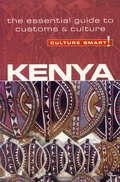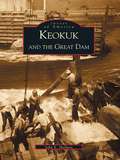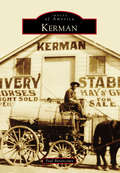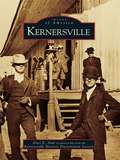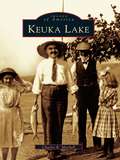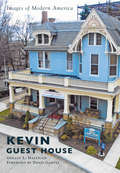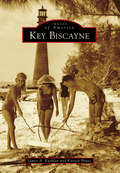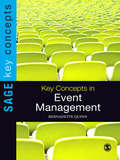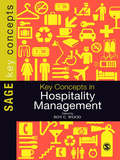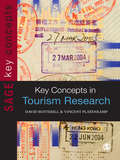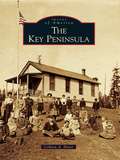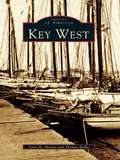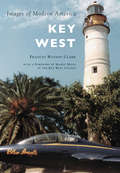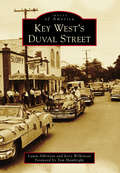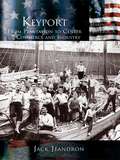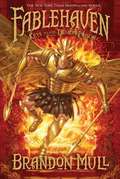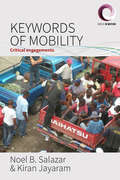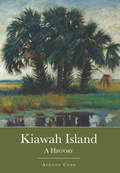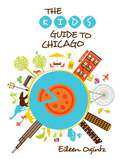- Table View
- List View
Kenya - Culture Smart!
by Jane BarsbyCulture Smart! provides essential information on attitudes, beliefs and behavior in different countries, ensuring that you arrive at your destination aware of basic manners, common courtesies, and sensitive issues. These concise guides tell you what to expect, how to behave, and how to establish a rapport with your hosts. This inside knowledge will enable you to steer clear of embarrassing gaffes and mistakes, feel confident in unfamiliar situations, and develop trust, friendships, and successful business relationships.Culture Smart! offers illuminating insights into the culture and society of a particular country. It will help you to turn your visit-whether on business or for pleasure-into a memorable and enriching experience. Contents include:* customs, values, and traditions* historical, religious, and political background* life at home* leisure, social, and cultural life* eating and drinking* do's, don'ts, and taboos* business practices* communication, spoken and unspoken"Culture Smart has come to the rescue of hapless travellers." Sunday Times Travel"... the perfect introduction to the weird, wonderful and downright odd quirks and customs of various countries." Global Travel"...full of fascinating-as well as common-sense-tips to help you avoid embarrassing faux pas." Observer"...as useful as they are entertaining." Easyjet Magazine"...offer glimpses into the psyche of a faraway world." New York Times
Keokuk and the Great Dam
by John E. HallwasThis remarkable pictorial history tells the story of an engineering marvel: the first dam built across theMississippi River (from 1910-1913), and the historicMidwestern community that fostered the world-famoushydroelectric project. Keokuk and the Great Dam is the story of a colorful and historic river town with a dream of economic development and cultural progress; a self-taught engineer who took on a challenge that no one else wanted to attempt; and a massive construction effort that pitted men and machines against the awesome power of America's greatest river. Completed shortly before WWI, the Keokuk dam (now known as Lock and Dam No. 19) was the culmination of a long struggle to employ the Mississippi River for hydroelectric power and to improve navigation on the great waterway. In frontier days the Des Moines Rapids, stretching north from Keokuk, prevented loaded steamboats from moving upriver. They also created a business opportunity for local residents. A rapidly growing town by the 1850s, Keokuk went into decline for many years when it failed to secure adequate railroad connections. But the coming of hydroelectric powerfostered a new dream, and local leaders set out to harness the great river. What followed was a dramatic effort that drew international attention, produced the world's second largest dam (at the time), and forever changed both the community and the fabled American waterway.
Kerman (Images of America)
by Paul BetancourtKerman sits in the heart of California's great San Joaquin Valley. First established in 1891 as a train stop for the Southern Pacific Railroad, the town site was originally named Collis Station for the railroad's president, Collis P. Huntington. Even in its earliest days, agriculture was the driving force behind Kerman's economy. Advances in irrigation as well as Kerman's close proximity to two of the region's largest rivers--Kings and San Joaquin--resulted in abundant access to water, attracting farmers and land investors at the start of the 20th century. As the community grew, alfalfa hay, raisins, and dairy products became mainstays in Kerman's agricultural production. By 1910, Kerman had a volunteer fire department, a library, and new businesses. Images of America: Kerman explores the first 80 years of a town that continues to grow and diversify.
Kernersville (Images of America)
by Kernersville Historic Preservation Society Alice E. SinkNative Americans first inhabited the eastern Forsyth County area, a natural watershed and source of six rivers and creeks. About 1756, Irishman Caleb Story settled here on 400 acres of wooded land. Years later, Story sold his land to David Morrow for a purported four gallons of rum. About 1771, William Dobson purchased the original acreage and additional tracts and built an inn near what is now Mountain Street and Main Street. He named this junction Dobson'sCrossroads. On June 2, 1791, President George Washington ate breakfast at Dobson's Tavern. On November 14, 1817, German-born Joseph Kerner (also spelled K¶rner) purchased the land and renamed the area Kerner's Crossroads. This begins the story of Kernersville. The same roads, still graced with historic churches, stores, and homes, crisscross at the heart of this community. K¶rner's Folly, which contains 22 rooms, housed the first private little theater in America.
Ketchikan: Alaska's Totemland
by Mary G. Balcombrief, but interesting, history of Ketchikan Alaska and it's surrounding area. Covers both the local indians and the white settlers.
Keuka Lake
by Charles R. MitchellNestled among the hills of western New York State is the beautiful lake Keuka, the Indian word for "canoe landing." Once visited, the loveliness and serenity of this particular lake in New York's Finger Lakes region draws people back. Visitors return to stay for a week or the summer, and tourists come back, often annually. Many who have lived or summered at the lake return to retire. Keuka Lake brings back the time period from 1850 to 1960, the era of black-and-white photography. Featured are the local grapes and wineries, the steamboats, the commercial activities on and around the lake, and the lake itself. Today, the boats are no longer steam powered and the wineries are more plentiful, but other aspects of life have not changed. The residents are hospitable; the pace is slow; the lake is resplendent and inviting.
Kevin Guest House (Images of Modern America)
by Gerald L. Halligan Denis GarveyWhile unknown to many living in western New York, the Kevin Guest House has served thousands of critically ill individuals and their families for over 40 years. Quietly nestled within the expanding Buffalo Niagara Medical Campus of Buffalo, New York, the demand for the facility continues to increase. The opening chapter is a testimony to the Speyser-Beer family, who originally owned the property. The second and third chapters memorialize the founders of the Kevin Guest House, the Garvey family of Sharon, Pennsylvania. The remaining chapters provide a virtual tour of the grounds and building expansions of 2016.
Key Biscayne
by Kirsten N. Hines James A. KushlanKey Biscayne is an island paradise umbilically connected to Miami by a three-and-a-half-mile-long causeway. Its recorded history is one of the longest in North America, starting five centuries ago with Juan Ponce de León's arrival, the second official landing of Europeans in North America after Columbus. For centuries, Key Biscayne was an important landmark for Gulf Stream mariners, and the Cape Florida Lighthouse, built in 1825, is the oldest remaining structure in the region. The key was the site of an infamous Indian attack, a Second Seminole War military base, scientific expeditions, a Civil War raid, a tropical plantation, and finally a residential village and county, state, and national parks. When the key served as Richard Nixon's vacation White House, its worldwide fame grew. Key Biscayne now hosts a multinational community and hundreds of thousands of visitors annually.
Key Concepts in Event Management (SAGE Key Concepts series)
by Bernadette QuinnIn recent years we have seen an enormous growth of festivals and event activity and the literature within the field is consequently huge. In order to make sense of this rapid and dynamic development, students are dependent on a book that can lead them through the myriad of theoretical frameworks offered.<P> <P> This book naturally situates itself in the middle of this need, offering a comprehensive and illuminating account of the festival and event field. Written with academic rigour yet accessible at the same time, Quinn proves herself to be an outstanding communicator and stimulator of knowledge. <P> International in content and timely in its up to date coverage of key topics, this will be an invaluable reference source for students from Event Management, Tourism and Leisure studies. It will also be of great use for students from Business Studies, Marketing, Cultural Studies and Geography.
Key Concepts in Hospitality Management (SAGE Key Concepts series)
by Roy C. WoodThis edited book covers the major concepts you are likely to encounter throughout their study within the hospitality field, giving a comprehensive and up-to-date overview as well as providing engaging everyday examples from around the world. <P><P> A leading figure in the field, Wood has successfully gathered international contributors with direct experience of hospitality management and the hospitality industry as a whole, ensuring both the academic, geographical and practical integrity of the book. <P> Key Concepts in Hospitality Management is written for undergraduate students and those studying short postgraduate or executive education courses in hospitality. It would also be of use to the general academic reader seeking information on the hospitality industry and hospitality management.
Key Concepts in Tourism Research (SAGE Key Concepts series)
by Vincent Platenkamp Dr David BotterillThis book walks students through the selection and application of research methods within Tourism. Experienced authors introduce the relevant language and theory of key methodologies and then develop them using strategic literature review and the inclusion of international examples which relate directly to tourism. Each concept sets the historical and philosophical context of a method alongside the practical application of the technique and provides: * authoritative and reliable data * informative cross-referencing * detailed discussion of theories and their critics * suggestions for further reading The book is a vital resource for all students of tourism, leisure and management.
Key Concepts in Tourist Studies (SAGE Key Concepts series)
by Melanie Smith Nicola Macleod Margaret Hart RobertsonTourism is the fourth biggest industry in the world. What are the key concepts in Tourist Studies? This essential resource for students of tourism contains concise and authoritative entries on: • Planning Tourism • Sustainable Tourism • Festivals and Events • Cultural Tourism • Economics of Tourism • Regeneration • The Experience Economy • Urban Tourism • Sex Tourism Shrewdly judged to suit the needs of the modern student, the book offers the basic materials, tools and guidance for making sense of tourism and gaining the best results in essays and exams.
Key Peninsula, The
by Collen SlaterThe Key Peninsula is a scenic finger of land that stretches south between Case and Carr Inlets in Washington State. Few people lived there before 1850, although Native Americans fished and hunted from temporary villages. Several communities, each with a unique history, took root near the various bays and inlets of the peninsula, and by the 1890s, many areas bustled with schools, post offices, mills, churches, and stores. Logging, orchards, and chicken farms supported these early pioneers. Cut off from the mainland, the waters of Puget Sound provided transportation. The famous Mosquito Fleet carried products such as fruit, seafood, chickens, eggs, and butter to Olympia, Tacoma, and Seattle until the advent of the ferries and, later, the bridges. Many of today's "oldtimers" are just two or three generations distant from the original hardy settlers, but the area's residents are proud of the heritage of this unique place they call home.
Key West (Images of America)
by Lynn M. Homan Thomas ReillyMuch more than the typical vacation destination, Key West combines a free-spirited ambiance with magnificent coral reefs, a unique historic legacy with an enduring artistic sensibility. For centuries, explorers and adventurers, immigrants and entrepreneurs, artists and wanderers have come to the island oasis, and today Key West, a city like no other, is home to them all. Through hurricanes, fires, labor strikes, and the tourism boom, the community of Key West has sustained a unique way of life and attracted a wide variety of people to its shores, including such famous figures as writers Ernest Hemingway and Tennessee Williams, President Harry Truman, and musician Jimmy Buffett. Whether strolling through the downtown historic district, searching eclectic shops for one-of-a-kind treasures, enjoying a piece of key lime pie, or participating in the look-alike contest during Hemingway Days, Key West offers endless opportunities for pleasure. The landmarks, the people, and the continuing story of Key West are the entertaining subject of this new photographic tribute.
Key West (Images of Modern America)
by Frances Watson Clark Mandy MilesKey West has a colorful history. It was the beachhead that protected the United States from the Soviet Union and Cuba in the 1960s, its literary and music scenes attracted and developed writers, artists, and musicians in the 1970s, and it seceded from the Union and created a new nation, the Conch Republic, in the 1980s. Through the rest of the decades to the present, festivals, celebrations, and revelries have drawn tourists here year-round and supported the Conchs, the key's residents. The vibrant community, people and places, military presence, and significant historic sites make Key West one of the most interesting places in the United States.
Key West Cottages and Gardens: Inspiration from America's Special Tropical Island
by Leslie LinsleyBright colors, floral patterns, and cottage styles are all design choices associated with the Florida Keys. Key West, one of the most famous tropical islands in the world, embodies the ideas of the Florida Keys while also presenting its own style and culture. In Leslie Linsley&’s Key West Cottages and Gardens, lovers of the Key West architectural and design style will get a chance to look at beautiful photos of tropical homes as well as learn tips for living on the island from Leslie and residents.Key West is home to a year-round population of about 35,000 with over one million travelers visiting throughout the year. Leslie&’s intimate interviews with residents allow readers a peek into what Key West cottage living is really like, even some of the potential challenges. The interviews and photos in this book will show how people live in all different styles of cottages. Whether you&’re a local who has made Key West home and want to learn new tips for living in your smaller, outdoor-friendly space or a tourist who loves the feeling and visuals of the Key West lifestyle, this book has you covered. Photos by Tamara Alvarez and home styling by Michael Pelkey.
Key West's Duval Street
by Jerry Wilkinson Laura Albritton Tom HambrightDuval Street, the pulsing heart of historic Key West, is one of the most legendary avenues in the United States. Stretching from the Atlantic Ocean to the Gulf of Mexico, this iconic thoroughfare has seen everyone from Ulysses S. Grant to Ernest Hemingway. Collecting remarkable archival photographs, Images of America: Key West�s Duval Street features famous buildings such as Key West�s Oldest House, St. Paul�s Church, the Southernmost House, the Strand Theater, the San Carlos Institute, and La Concha Hotel, along with fabled bars like Sloppy Joe�s and the Bull & Whistle. This book celebrates the irrepressible spirit and heritage of a much-beloved American destination.
Key West: Paradise Found
by Ellen T. WhiteThe ultimate getaway destination, a.k.a. the famed southernmost point of the United States, Key West offers visitors spectacular lodging, dining, and sea adventures year-round. But as its devotees know, it's the island's tales, over-the-top characters, and quirky history of pirates and wreckers that give it its charm. With stunning images by Missy Janes, photographer for Pineapple Press&’ Palm Beach, this book is a visual journey around the island capturing its teeming life and storied past—from the sunset show on Mallory Square, to the haunted Civil War forts, and the revered Hemingway House, as well as stops along the "Duval Crawl" and iconic eateries like Louie's Backyard and Blue Heaven. And then there are the miles of beaches, epic fishing flats, and marine sanctuaries. The ideal keepsake for visitors, wedding guests and all who cherish the free-spirited island getaway.
Keyport: From Plantation to Center of Commerce and Industry
by Jack JeandronEmerging from the shores of the Raritan Bay, Keyport's roots trace back to the Kearney family's plantation and its vital role during Revolutionary times. Although just 1.4 square miles in size, it encompasses shipbuilding, oyster farming, a trolley network, and an Aeromarine industry within a rich and influential history. Beyond these are the abundant and captivating tales of catastrophic fires and the vaunted Prohibition days providing a colorful framework of life in this coastline community.
Keys to the Demon Prison (Fablehaven Series, Book #5)
by Brandon MullFor centuries, mystical creatures of all description were gathered in a hidden refuge called Fablehaven to prevent their extinction. The sanctuary survives today as one of the last strongholds of true magic in a cynical world.
Keywords of Mobility: Critical Engagements
by Kiran Jayaram Noel B. SalazarScholars from various disciplines have used key concepts to grasp mobilities, but as of yet, a working vocabulary of these has not been fully developed. Given this context and inspired in part by Raymond Williams' Keywords (1976), this edited volume presents contributions that critically analyze mobility-related keywords: capital, cosmopolitanism, freedom, gender, immobility, infrastructure, motility, and regime. Each chapter provides an historical context, a critical analysis of how the keyword has been used in relation to mobility, and a conclusion that proposes future usage or research.
Kiawah Island: A History (Brief History)
by Ashton CobbKiawah Island, located on the picturesque South Carolina coast in the heart of the Lowcountry, has a well-deserved reputation as a world-renowned destination. With its pristine beaches, award-winning golf courses and spectacular resort, Kiawah beckons to thousands of visitors from across the globe each year. Kiawah's charm, however, goes far beyond its breathtaking natural beauty and vaunted destination status. Unknown to many, the history of this beloved sea island is as captivating as its celebrated shoreline; its past as compelling as #17 on the Ocean Course. This landmark new book reveals the history of Kiawah Island as never before. Since the early eighteenth century, Kiawah has been used for myriad purposes by a wide variety of inhabitants. Kiawah Island: A History, by historian Ashton Cobb, provides a comprehensive consideration of the diverse factors and factions that have combined to shape Kiawah's fascinating history. Cobb calls upon a wide array of sources to tell the story of a South Carolina sea island that has been the site of great change through the centuries, but has remained a treasured location for generations of inhabitants and devoted visitors.
Kibo ("Brimming with Hope")
by Elizabeth AndohThis cookbook is a heartfelt and fascinating tribute to the food, traditions, and courage of the people of Japan's Tohoku region before and after the devastation of the earthquake and tsunami of March 11, 2011. It features traditional recipes such as Miso-Seared Scallops, Pinched-Noodle Soup with Pork, Salmon-Stuffed Kelp Rolls, and basics like rice, stocks, and sauces, along with sake pairings and essays on Japan in recovery from journalists and food writers. Kibō was written by Japanese culinary authority Elizabeth Andoh, who was in her Tokyo kitchen when the Great Eastern-Japan Earthquake struck. Over the following months she witnessed the strength of the people of the Tohoku region--one of the largest miso- and sake-producing areas in Japan--as they struggled with the effects of the resulting tsunami and nuclear accident. She was inspired to write Kibō (meaning "brimming with hope") to not only tell the story of the food of the Tohoku region but also to document the experiences of its people, both before and after the disaster. This lushly photographed original eBook will honor the region and its rich culture on the first anniversary of the earthquake, with a portion of the proceeds going to Japanese recovery efforts.
Kid's Guide to Boston (Kid's Guides Series)
by Eileen OgintzBefore you plan your family’s next excursion, get some help from a travel professional…and your kids! The Kid’s Guide series lets the kids help plan your trip and guides you as you explore your destination. Inside you’ll find kid-tested tips on where to go, where to eat, what to see, and where to get the best souvenirs. Along the way, your kids will be engaged by reading and sharing fun acts and cool travel tips. Awesome games and quizzes keep the family entertained! Fun for both visiting and local kids!
Kid's Guide to Chicago (Kid's Guides Series)
by Eileen OgintzBefore you plan your family’s next excursion to Chicago, get some help from a travel professional… and your kids! The Kid’s Guide to Chicago lets the kids help plan the trip and guides you as you explore the city. Inside you’ll find kid-tested tips on where to go, where to eat, what to see, and where to get the best souvenirs. Along the way, your kids will be engaged by reading and sharing fun Chicago facts and cool travel tips. Awesome games and quizzes will keep the family entertained.
